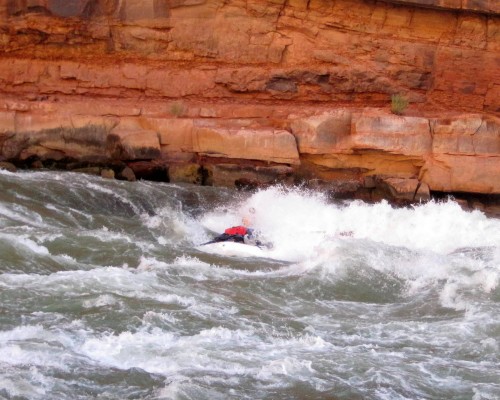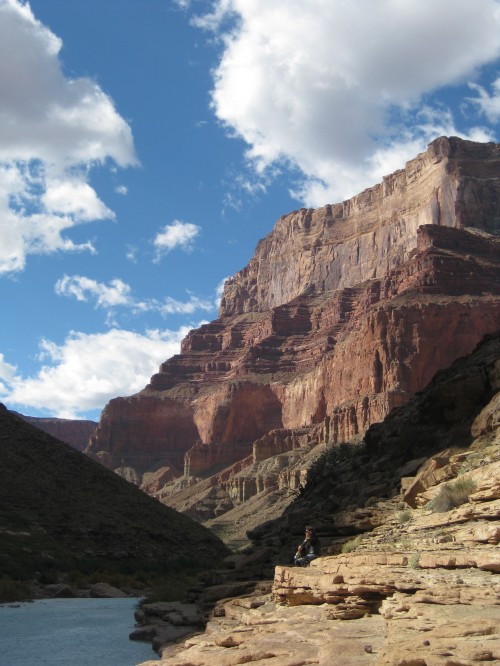Road Trip: Exploring the Grand Canyon, part 1

[The third installment in our ongoing Road Trip series, in which Institute staff visit other amazing places around the country and bring back stories and photos to share! This article is the first of a three-part series.]
On the morning of November 11th, one of our boatmen sat perched on the bow of his raft and read the following from John Wesley Powell’s journal:
With some feeling of anxiety we enter a new canyon this morning. We have learned to observe closely the texture of the rock. In softer strata we have a quiet river, in harder we find rapids and falls. Below us are the limestones and hard sandstones which we found in Cataract Canyon. This bodes toil and danger.
Shortly after, we pushed off from the shores of Lees Ferry–river mile zero of the Grand Canyon. For the next 20 days, I would travel 226 miles on the great Colorado with fifteen other people and the words of John Wesley Powell and Edward Abbey.
On our first day we traveled 16 miles down the Colorado, sitting 1,800 feet below the canyon rim. We set out on our voyage with four 18 foot rafts, four white water kayaks and one inflatable kayak that would fit 16 people and 20 days worth of gear. Our permit through Grand Canyon National Park required us to finish our trip to Diamond Creek in 20 days with no help from a professional guide. However, we were able to pay an outfitter to provide us with the necessary rafts and food planning to get us through our journey.
Outside of the normal gear expected for a trip of this magnitude, we also brought mustaches, glow sticks, 1,500 beers (you get thirsty floating), a costume bag and dance music.  For the next 20 days we would be floating through what has been deemed one of the Seven Wonders of the Natural World. No words can ever truly describe the anticipation and wonder we had as we set forth down the river on our first day, except that it seemed as if we were traveling through a moving, living painting.Â
For two of our boatmen, it was their first time floating the Grand Canyon, let alone their first time rowing a raft. As a precautionary measure, we took our time and scouted our first major rapid: Badger. The rapids of the Grand Canyon are rated on a scale of 1 – 10, versus the traditional whitewater system of class 1 – 6. The Grand Canyon rating system was developed with heavily loaded rafts in mind in order to forewarn rafters of what lies ahead. Our four oarsmen made it through Badger (rated a 5) successfully, as did our three white-water kayakers.
We ended our first day on the Colorado River around a campfire watching the sun set over the canyon walls. The walls were streaked orange and gold with white stripes of sandstone separating the ancient layers of rock. Many nights were spent trying to comprehend the age of the rock around us and how the water moved, almost as it was alive, shaping, carving and smoothing the rock wall. The rock surrounding us on this night was from the Toroweap Formation, made up of layers of sand over 260 million years old. To end the day, we read aloud an excerpt from Edward Abbey’s journal.  Ed Abbey traveled the Grand Canyon many times when he worked at Lees Ferry in Grand Canyon National Park as a park ranger. His last journey was made in 1977 as a passenger and author. He writes of his first evening:
One more nip on the Ron Rico and two more songs and then I slip away. I unroll my sleeping bag, but the air is so warm I hardly need to crawl into it. By dawn I will. Two shooting stars trace lingering parabolas of blue fire across the sky. From below rises the sound of rowdy, unseemly music. Crickets chirp. The steady, rhythmic rumble of the river pouring over the rocks is somehow soothing. I soon drop off to sleep.
Group members reparing for the roar ahead on the Colorado River. Photo by Frankie Devlin
Our second day was a little spicier than the first, care of House Rock Rapid (rated a 7).  I should mention that I have never been in a raft before and have an unhealthy fear of flipped rafts, and the possibility of getting stuck under the flipped boat and nearby rocks. At this time, my friend Stewart was at the oars and we dropped down the brown tongue of the Colorado into House Rock Rapid. We hit the first wave straight on, which knocked us sideways. Stewart was unable to turn the raft in time, and the next wave crashed over the side of the boat and swept us both into the river.
I surfaced under the boat and pushed frantically away in order to find air.  When I finally breached the surface the raft that was once carrying me floated by, with Stewart hanging onto the flip lines. My greatest fear realized, I cried for help, but no one was nearby. It felt like an eternity passed before a throw bag was finally tossed to me. What I deemed an incredibly harrowing and near-death experience was really only 30 seconds long, and I was in no danger.
Cruising through the House Rock Rapid, seconds before falling out. Photo by Frankie Devlin
After House Rock Rapid, we survived the Roaring 20’s, which has 10 rapids in a 10-mile stretch of river, with ratings of 5 through 7. The focus of the next three days and 40 miles of our trip was to enjoy the calm waters of the Colorado and explore the canyon and its geologic history. Our first stop was at Redwall Cavern, described by Powell as:
A vast half-circular chamber, which if utilized for a theater, would give seating to 50,000 people.
We chose to utilize the vast chamber, which could probably only seat 5,000 people, as a yoga studio and the ultimate Horseshoe venue of the century. We relaxed and explored the cavern for quite some time reflecting on the power water has had in creating the Grand Canyon. One of my fellow travelers found a set of scorpion tracks left in the sand. He could be found for the next 20 minutes crawling along the sandy floor trying to find the culprit. 
Playing a game of horseshoes in Redwall Cavern. Photo by Stephanie Bennett
After some exploring and down time in Redwall Cavern, we camped at Main Nankoweap Camp. The camp site has a trail which leads 1,500 feet above the river to the Nankoweap Granaries. The granaries, built by the Anasazi people, are believed to be from the period 1050-1150 A.D.  One can only begin to guess of the benefits of having a granary sitting atop a cliff 1,500 feet from your village below, but for us that evening, it provided an amazing location to view the setting sun over the river flowing west.
Views of Lynette, the granaries and the Grand Canyon. Photo by Dave Yogg
On our fifth day we reached mile 62, where the cold and brown Colorado River is joined with its bright and beautiful counterpart, the Little Colorado.  The Little Colorado’s bright blue color is attributed to the large amount of various minerals traveling through the water. We spent our afternoon that day eating lunch by the river, reflecting on the past five days of our journey. We were only a quarter of the way through our voyage, yet every day remained new and exciting. The boats were beginning to feel like home. From our camp that evening, we could see the sun set over the canyon walls that towered nearly 3,000 feet above our tent. I fell into a deep sleep that evening with the full moon flooding our tent, unaware of what was to come ahead on our journey: the Inner Gorge.
Scott contemplating the Little Colorado. Photo by Stephanie Bennett
Â






VERY nice writing and photographs! Kudos. I am coming up on the anniversary of my first year working for the oldest Grand Canyon river rafting company, Canyoneers. I work in the office talking to people who call and email, asking about availability and what each type of trip involves. (So instead of being a river guide, I’m a river trip planning guide).